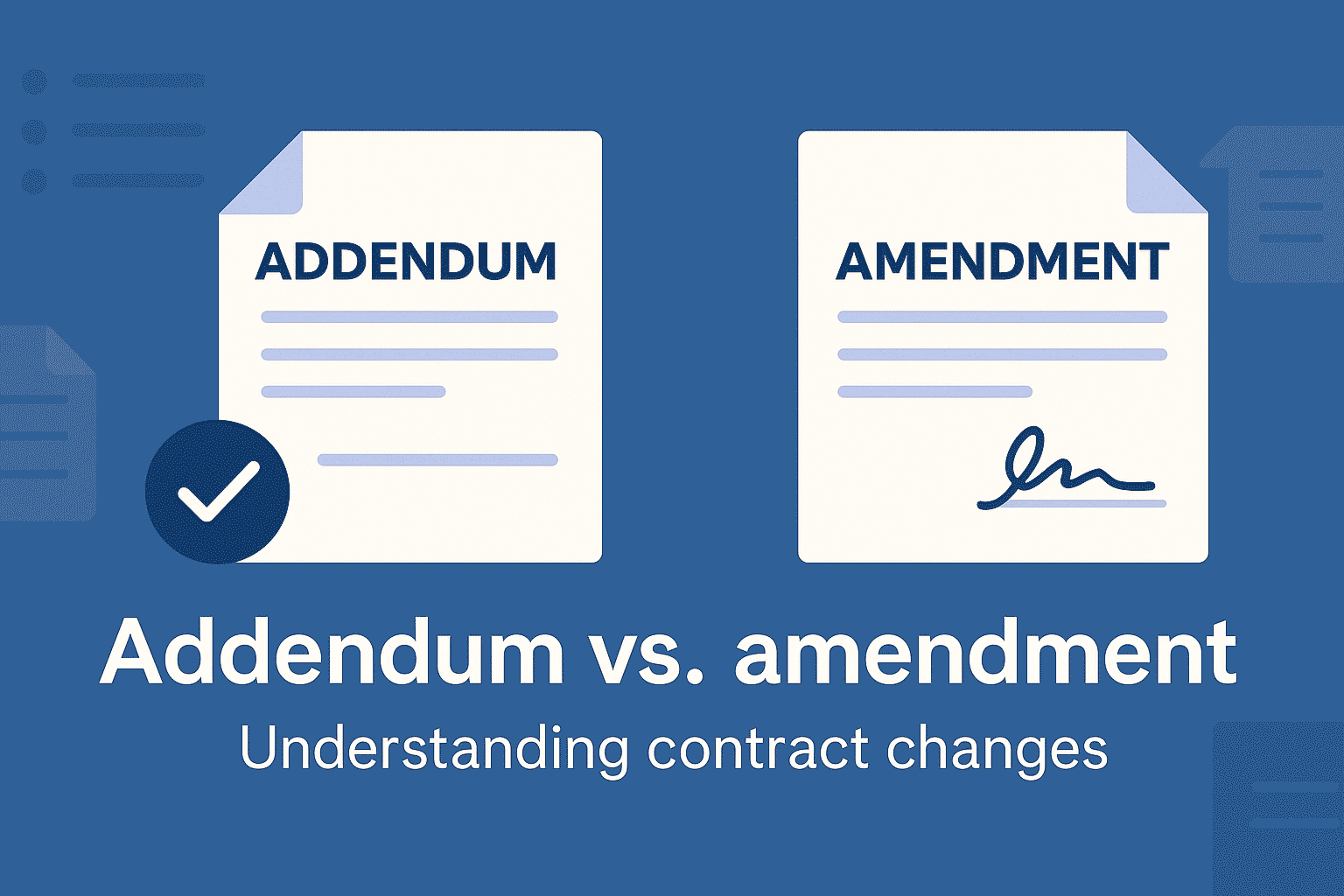release:
update:
Addendum vs. amendment: Understanding contract changes

Table of contents
Addendum vs amendment is one of the most common questions that comes up when reviewing contracts. Both terms describe ways to change an agreement, but they work in different ways.
Knowing the difference matters because each option has legal and practical effects. Misusing them can cause confusion or disputes, while using them correctly keeps agreements clear and enforceable.
See why businesses are rushing to SignTime’s feature-packed contract repository system.
What is an amendment in a contract?
An amendment is a formal change to the text of an existing contract. It replaces or adjusts specific clauses rather than adding new material. The amendment becomes part of the original agreement once both parties approve it.
Amendments are often used when the terms of a deal shift but the overall relationship stays in place. They make sure the written agreement reflects current reality without requiring a brand-new contract.
Common examples of amendments
Amendments can apply to many types of changes in a contract. The most frequent examples include the following:
- A price adjustment changes the fees or rates that were agreed to at the start.
- A time extension adds more months or years to the contract duration, while a shortening reduces the term.
- A scope revision alters the specific work or deliverables outlined in the agreement.
- A payment modification, for example in a managed services agreement, updates how and when payments are made, such as due dates or installment schedules.
What is an addendum in a contract?
An addendum is a document that adds new material to an existing contract without changing the original text. It supplements the agreement, usually by attaching extra details or clarifications. Once both parties sign, the addendum becomes legally binding as part of the contract.
Addendums are useful when extra information is needed but the core contract terms stay the same. They keep the original agreement intact while making sure new details are recorded in an organized way.
Common examples of addendums
Addendums appear in many industries and can take different forms depending on the contract. Some of the most common include the following:
- A schedule or appendix adds supporting information such as project timelines or technical specifications.
- A product or service detail sheet outlines additional items being provided under the same agreement.
- A compliance update inserts new policy requirements or legal disclosures into the contract.
- An expansion of services describes optional features or future work that both parties agree to in advance.
Key differences between addendum and amendment
Although both addendums and amendments are tools for updating contracts, they work in different ways. Understanding these differences helps ensure the right type of change is used.
The main points of distinction can be summarized as follows:
- An amendment alters the text of the original contract, while an addendum leaves the text unchanged and attaches new material.
- An amendment is usually formatted as a marked change to specific clauses, while an addendum is presented as a separate document that is attached.
- An amendment is common when terms like price, scope, or duration shift, while an addendum is used when new information or documents need to be added.
- Both require proper agreement and signatures, but the risk of confusion is higher if the wrong type is chosen for the situation.
How to decide whether you need an addendum or an amendment
Choosing between an addendum and an amendment depends on the type of change being made. The goal is to match the tool to the situation so the contract stays clear and enforceable.
You can use the following questions to guide the decision:
- Is the existing text of the contract incorrect or outdated? If so, an amendment is usually the right choice.
- Do you need to add new details without removing or rewriting existing terms? If so, an addendum is often more appropriate.
- Will the change affect payment, scope, or timing? If yes, an amendment keeps those updates integrated into the original text.
- Are you including supporting documents or optional details? If yes, an addendum is the cleaner approach.
Asking these questions before drafting saves time and reduces the risk of later disputes.
Best practices for managing contract changes
Managing contract changes carefully ensures agreements remain clear and enforceable. Following structured processes reduces confusion and protects both parties.
Some key best practices include the following:
- Keep a clear record of every amendment and addendum so changes are easy to track.
- Make sure all changes receive proper approvals and signatures before being finalized.
- Use consistent language and formatting across all documents to avoid misunderstandings.
- Store and organize all versions in a secure repository so they are accessible when needed.
- Review contracts regularly to ensure all updates are documented and nothing is overlooked.
SignTime makes contract management easy
SignTime simplifies the process of creating, signing, and storing both amendments and addendums. It ensures that every change is properly recorded and accessible when needed.
Integrated approval workflows make sure the right people review and approve contract changes. Multiple e-signature options, including typed, hand-drawn, or hanko, accommodate different business preferences.
Salesforce integration and a built-in contract repository keep all versions organized and easy to track. Long-term e-signature support provides additional assurance for agreements that last over time. Using SignTime helps businesses manage contract updates efficiently and with confidence.
Download our brochure to see whether SignTime might be a fit for your organization.
